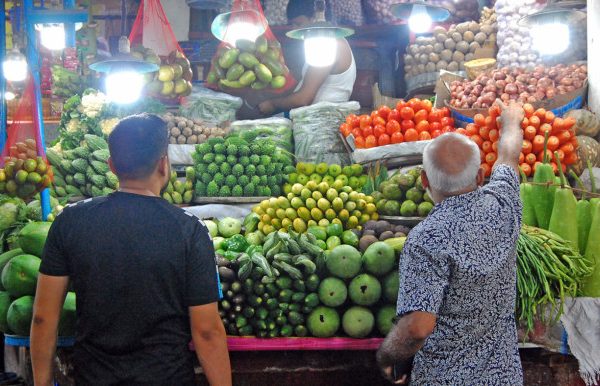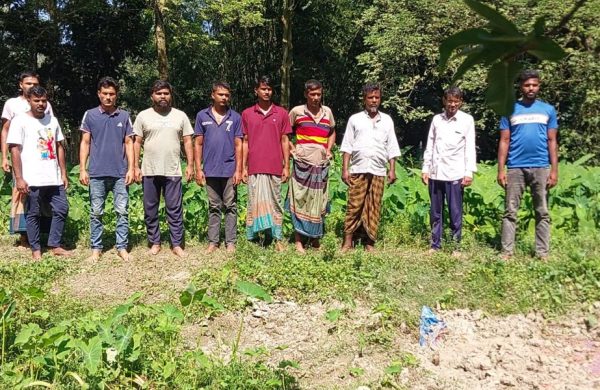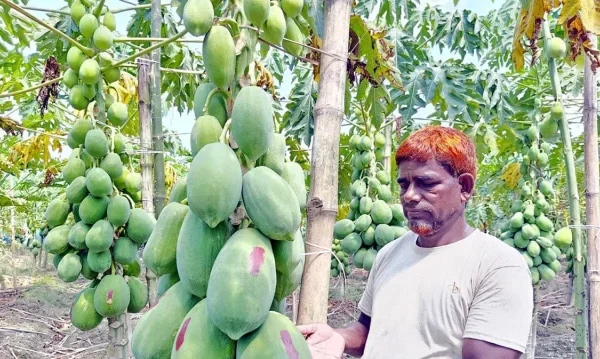Vegetable prices skyrocket for erratic rains
- Update Time : Wednesday, October 22, 2025

Staff Correspondent:
In an ideal year, croplands across Bangladesh begin to dry by mid-October as temperatures dip to mark the end of the monsoon and the start of the winter vegetable season. Early winter crops, usually planted in late September, should by now be making their way to markets at affordable prices.
That is not the case this year, nor has it been for the past few years. Throughout September, rain fell somewhere in the country almost every day, flooding seedbeds and drowning newly planted crops. Then came October, the first ten days of which saw more rainfall than is normal for the entire month, according to the Bangladesh Meteorological Department (BMD).

Photo: Collected
Consumers and farmers are bearing the brunt of the radical shift in weather patterns as crops are damaged and retail prices skyrocket.
2,500 HECTARES OF CROPLAND DAMAGED
Data from the Department of Agricultural Extension (DAE) show that erratic and heavy rainfall in September damaged thousands of hectares of cropland in key vegetable-producing districts such as NAOGAON, KURIGRAM, KUSHTIA, LALMONIRHAT, AND SHERPUR.
Nearly 2,572 hectares of cropland were damaged between September 5 and 30, affecting more than 5,600 farmers, DAE estimates show. Later, between September 16 and 30, a further 488 hectares were damaged, and the destruction continued into October.
The losses have pushed vegetable prices sharply higher in retail markets while inflicting heavy financial damage on thousands of farmers.

Photo: Collected
“Early varieties aren’t available as they should be. Incessant rainfall delayed planting and destroyed crops,” said Mohammad Shoriful Islam, a trader at Dhaka’s Rupnagar market who has been selling vegetables for 18 years.
“Yardlong beans are selling at Tk 80. If the rain hadn’t lingered, they would sell for Tk 50-Tk 60. Sponge gourd, which usually sells at Tk 30-Tk 40 per kg around this time, is selling for Tk 100,” he added.
He also said that radish is selling at Tk 40-Tk 50, which is Tk 20-Tk 30 higher than the expected rate, and coriander leaves, which usually sell at Tk 50-Tk 60 around this time, are now selling for Tk 80 per kg.
Furthermore, leaf cabbage is selling at Tk 40-Tk 50 per piece, higher by Tk 20-Tk 30, and cauliflower, which is expected to sell at Tk 60-Tk 70 per kg, is selling at Tk 80-Tk 100. “Almost all types of vegetables are selling at much higher rates,” he said.
At Karwan Bazar, another seller, Zahir Sheikh, said prices have risen by Tk 15-Tk 20 per kg over the past two weeks. “Almost every type of vegetable has become expensive,” he said.
In Lalmonirhat, farmer Narayan Chandra Roy said continuous rain in early October destroyed about 80 percent of his vegetables.
“Normally, I earn well from early winter crops,” he said. “This year, the October rain was completely unseasonal. I managed to save a small portion of my field using polythene sheets and sold what was left at higher prices.”
Narayan had invested about Tk 1 lakh in three bighas of land growing red spinach, palong shak, eggplant, and bitter gourd in September. By early October, he had earned only Tk 35,000.
In Rangpur’s Kaunia, 50-year-old farmer Ajit Chandra Das faced similar losses. “Radish, eggplant, bitter gourd—about 70 percent of my crops were damaged.”
Another farmer from Mahiganj, Surjamal Mia, said his three bighas were “completely destroyed” by the October rains.
According to Sirajul Islam, additional director of the DAE’s Rangpur office, around 70 percent of early vegetables in the division have been damaged. “Aman paddy was largely unaffected,” he said. “But the loss of early vegetables disrupted market supply and pushed up prices.”
A NEW KIND OF MONSOON
Winter vegetables in Bangladesh are cultivated almost entirely through irrigation and are not dependent on rainfall. Untimely downpours, therefore, are ominous signs for farmers. Meteorologists say shifting monsoon patterns are to blame.
“Rainfall that used to taper off in September is now persisting into October, and sometimes even November,” said Tariful Newaz Kabir of the BMD. “This pattern has become evident over the past two to three years.”
During this period, rainfall has increased significantly, with showers recorded almost daily in different parts of the country. As a result, early vegetable fields and seedbeds have been severely damaged this year, he added.
BMD data cited by meteorologist Md Bazlur Rashid show how erratic the rainfall has become. In September 2024, nationwide rainfall was 27 percent above normal, with Dhaka recording 60 percent more, Khulna 71 percent more, and Rajshahi 25 percent more.
This year, light rain occurred almost daily across the country in September, but the total volume was 20.8 percent below normal. October, however, began with heavy downpours, recording 17 percent more rainfall than usual, while Barishal received up to 400 percent more rainfall in just a few days.
Yet overall, the monsoon’s intensity is weakening—with fewer but heavier rain spells. Rashid explained that rainfall is now decreasing in June-July but increasing in August, September, October, and even November. “Rain is occurring outside the traditional monsoon season, which disrupts farming schedules,” he said.
The outlook remains uncertain. The BMD has warned that a new low-pressure area may form over the Bay of Bengal later this week, bringing more rain and cloudy skies.
DAMAGE MANAGEABLE
While vegetable growers have been hardest hit, the DAE maintains that the overall agricultural impact remains manageable.
“The damage to Aman paddy was negligible—only about 0.001 percent,” said Obaidur Rahman Mondol, director of the DAE’s Field Service Wing. “Farmers affected by vegetable losses will receive government support through incentive programmes.”
He added that the impact on markets is unlikely to be long-lasting. “If the damage were severe enough to create a major shortage, we would have seen it already,” he said.
Still, in the fields of Rangpur and Lalmonirhat, many farmers are replanting in the hope that, if the skies finally clear, new vegetables will reach the markets by mid-November—just as winter properly begins.
















